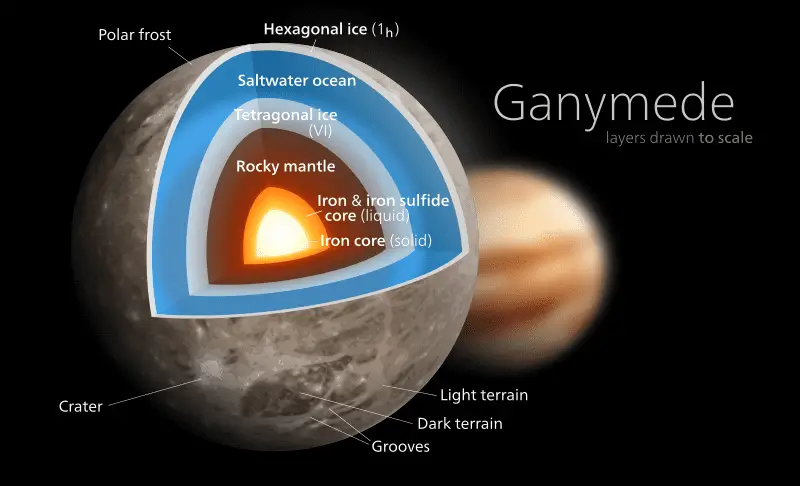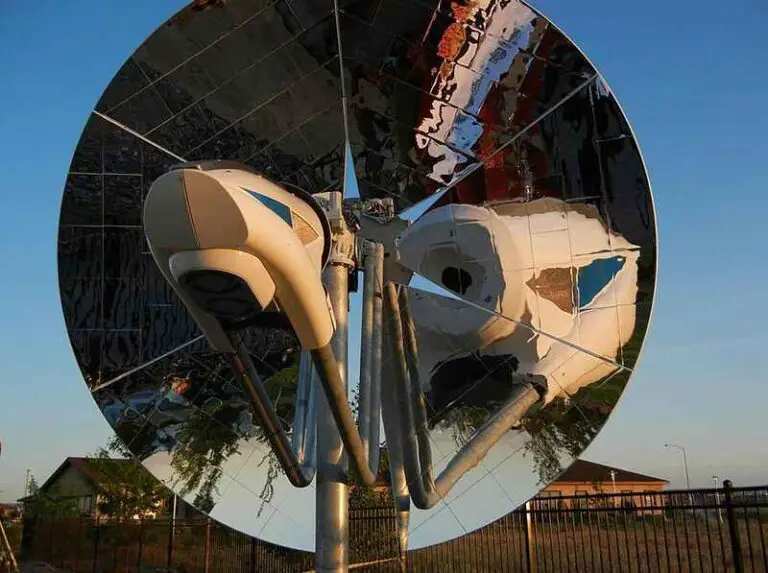7 Largest Moons in the Solar System and Their Characteristics
Largest moons in the solar system are; Ganymede, Titan, Callisto, Io, Luna, Europa, and Triton.
This article discusses some of the largest moons in the solar system, as follows;
1). Ganymede (as one of the Largest Moons in the Solar System)
Ganymede moon is the largest moon in the solar system.
It is a natural satellite that revolves around Jupiter, and has a radius of about 2,631 kilometers, or 1,635 miles [4].
In terms of size parameters like surface area, perimeter and volume, Ganymede moon exceeds even some of the smaller planets like Pluto and Mercury.
Some facts about Ganymede are;
1. The size of Ganymede moon is among the only planet-comparable sizes for a moon in the solar system
2. Ganymede derives from Greek mythology; wherein the name is borne by a said 'Trojan Prince' and cupbearer to Greek Gods
3. There is significant geographic and geologic diversity on the surface of Ganymede; which includes craters, ridges and multiple rock types
4. Ganymede is the only moon in the solar system that is known to have a geomagnetic field [3], which occurs due to the presence of ferrous minerals in its core (just as they are present in the Earth's core)
5. The subsurface region underneath Ganymede's crust contains vast amounts of water in liquid phase, whose magnitude is similar to that of the Earth's marine biome. These water accumulations are often referred to as subsurface oceans
While it has not been the topic of any particularly-extensive research so far, there are speculations that Ganymede moon has significant influence on the dynamics of its cosmological ecosystem, affecting parameters like electromagnetic radiation, gravitational pull, and thermal energy distribution. This influence is largely caused by its sheer size.

2). Titan
Titan is the second-largest moon in the solar system, and revolves around the planet Saturn.
In spite of its significant mass, Titan is not larger than Earth. Small planets like Mercury are also bigger than Titan, with the exception of Pluto; which is a dwarf planet.
These observations validate the earlier claim (in section 1 of this article) that Ganymede is the only moon in the solar system with comparable dimensions to those (dimensions) typical of planets.
The diameter of Titan moon is about 5,150 kilometers, or 3,200 miles [2]. This places it among the three largest moons in our solar system, alongside Ganymede and Callisto.
3). Callisto (as one of the Largest Moons in the Solar System)
Callisto is the third-largest moon in the solar system, falling behind Ganymede and Titan in mass and volume. It is one of Jupiter's natural satellites.
The diameter of Callisto moon is approximately 4,821 kilometers, or 2,995 miles.
Some facts about Callisto are;
1. Callisto is a rocky planetesimal, comprising mainly of rock, water (fresh, saline) and ice
2. There is minimal geologic diversity or activity on Callisto, both on and underneath the surface. This includes lack of significant tectonics and volcanism
3. Collisions with other cosmological bodies in the course of its evolutionary history have led to the formation of craters on Callisto's surface
4. Callisto possesses an induced electromagnetic field as a result of its proximity to Jupiter, around which it revolves. This induced field is similar to that which forms around rotary components of electric motors and generators
5. Space exploration efforts within the vicinity of Jupiter and its moons reveal that Callisto may have subsurface oceans similar to those of Ganymede
Lastly, Castillo is larger than dwarf planets like Pluto.
4). Io
Io is a large moon, having diameter of about 3,642 kilometers or 2,263 miles.
While being significantly large, Io is not the biggest moon in the solar system, as if is often erroneously portrayed. It rather comes fourth in ascending order of size, behind Ganymede, Titan and Castillo. Io is also one of Jupiter's natural satellites, alongside Castillo.
Like Ganymede, Io is characterized by significant geologic diversity and activity.
Gravitational influence of Jupiter (around which it revolves) and its own characteristics make Io susceptible to volcanic eruptions that continually modify its surface.
Lastly, the presence of various chemical compounds on its surface gives Io a distinctive appearance by which it is distinguished from other moons.

5). Luna (as one of the Largest Moons in the Solar System)
Luna is the Earth's moon and fifth largest in the solar system.
It has a diameter of about 3,475 kilometers, or 2,159 miles [5], and is one of the most explored moons, having been the subject of extensive research using various analytical methods and types of spacecrafts.
Luna orbits the Earth at a distance of approximately 384,000 kilometers or 238,900 miles. It is comprised mainly of rocky material and has significant geologic diversity on its surface; including the presence of lava-flow structures, craters, highlands and plains.
Due to its proximity, Luna undoubtedly has influence on gravitational conditions on the Earth's surface, which in turn control the formation and dynamics of wind, waves and tidal forces.
Space explorations of Luna include the Apollo missions of 1969 to 1972, which involved the landing of spacecraft on the moon's surface, and collection of significant data [1]. Future exploration is very likely to occur, especially in the light of speculations that Luna could harbor significant amounts of minerals and energy resources.

6). Europa
Europa is the sixth-largest moon in the solar system, and one of the orbiting natural satellites of Jupiter.
It has a diameter of about 3,100 kilometers, or 1,940 miles, and comprises mainly of ice and water.
Geologic attributes of Europa moon include the presence of fractures, rifts, faults and ridges on its surface.
Tectonic processes that occur on Europa have led to the formation of multiple linear fractures called linea.
Lastly, this moon also comprised of subsurface oceans and significant chemical activity.
7). Triton (as one of the Largest Moons in the Solar System)
Triton is the 7th-largest moon in the solar system, as well as the largest of 13 moons orbiting Neptune.
The name Triton comes from Greek mythology and religion, where it is born by the sea god and son of Poseidon.
Although smaller than other large moons like Ganymede, Triton has an impressive mass, with its diameter being approximately 2,706 kilometers or 1,608 miles.
It has some distinctive characteristics including a thin atmosphere and notable geologic as well as geothermal activity.
The orbital rotation of Triton is also different from that of other large moons, and is often described as being retrograde. This is because its orbital direction is opposite that of Neptune around which it revolves.
Explanations of the unique orbital characteristics of Triton suggest that this moon may have formed in a different region from Neptune, and was subsequently captured into Neptune's orbit.
Conclusion
Largest moons in the solar system include;
1. Ganymede
2. Titan
3. Callisto
4. Io
5. Luna
6. Europa
7. Triton
References
1). Crawford, I. A.; Joy, K. (2014). "Lunar Exploration: Opening a Window into the History and Evolution of the Inner Solar System." Philosophical Transactions of The Royal Society A Mathematical Physical and Engineering Sciences 372(2024). Available at: https://doi.org/10.1098/rsta.2013.0315. (Accessed 20 May 2023).
2). Debata, P. K. (2015). "The Moon." Available at: https://www.researchgate.net/publication/279971655_The_Moon. (Accessed 20 May 2023).
3). Kivelson, M. G.; Khurana, K.; Volwerk, M. (2002). "The Permanent and Inductive Magnetic Moments of Ganymede." Icarus 157(2):507-522. Available at: https://doi.org/10.1006/icar.2002.6834. (Accessed 20 May 2023).
4). Mlinar, A. B.; Pappalardo, T. R.; Stevenson, D. (2001). "Rise of Deep Melt into Ganymede's Ocean and Implications for Astrobiology." Available at: https://www.researchgate.net/publication/241238940_Rise_of_Deep_Melt_into_Ganymede's_Ocean_and_Implications_for_Astrobiology. (Accessed 20 May 2023).
5). Tat, M. E. (2022). "A proposal of a unit of length for space in SI and English unit systems helps to imagine the universe." Available at: https://doi.org/10.21203/rs.3.rs-2210223/v1. (Accessed 20 May 2023).


